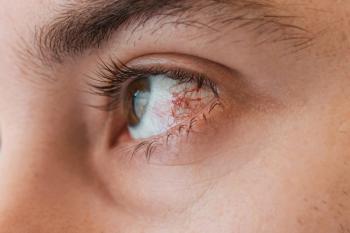
- January digital edition 2024
- Volume 16
- Issue 01
Cut out the cigarettes for the sake of the optic nerve
Recent research gives clinicians another reason to encourage cessation.
It is widely accepted that the smoking of cigarettes can cause damage to pretty much every tissue in the human body, and it It has been implicated as a risk factor for several eye diseases, such as age-related macular degeneration.1 What about a link between smoking with regards to and What about a link between smoking with regards to and
With these notions in mind, the authors of a recent cross-sectional study sought out to further explore the relationship of between smoking cigarettes to and the development and/or progression of glaucoma.5 The study investigators performed a cross-sectional study on 223 eyes of 163 patients who had participated in the Diagnostic Innovations in Glaucoma Study (DIGS) (NCT00221897). All of the participating patients included had undergone optical coherence tomography angiography (OCTA) and had completed a questionnaire regarding about their smoking history of smoking.
Due to the low number of study participants currently smoking (n = 2), current smokers were excluded from the study. Also excluded were patients with a history of trauma or intraocular surgery. In order to To be included in this study, participants had to be at least 18 years old, have best corrected distance visual acuities of 20/40 or better at the time they entered the study, and have open angles as determined by gonioscopy. Those excluded were patients with a history of trauma or intraocular surgery. Patients who had undergone uncomplicated cataract or glaucoma surgery were granted inclusion. The presence of retinal disease, uveitis, optic neuropathies other than glaucoma, axial length greater or equal to 27mm, and certain neurological diseases or history of stroke were also criteria for exclusion. An additional 12 eyes were excluded due to the poor image quality or their OCTA studies.
The investigators showed that a history of smoking was associated with larger choroidal microvasculature dropout areas, (as determined by OCTA studies). This was especially true for study participants with more severe glaucoma, (as determined by mean deviation analysis on visual field studies). It is important to note that no association was isolated between a greater degree of microvasculature dropout in smokers with early glaucoma.
The study authors noted that several mechanisms may be have been at play with respect to the effects of smoking on a cellular level.5 They suggest the effect of smoking on platelet aggregation and endothelial cell function within blood vessels. As wellAlso, nicotine has been shown to induce vasospasm and narrowing of capillary diameter, which could lead to occlusions.
The study does did have several limitations. The sample sizes — especially for heavy smokers — are were relatively limited. Also, the study participants filled out questionnaires regarding their smoking history. of smoking and smoking habits. Any such self-reported design leaves room for inaccuracy in reporting. The investigators also pointed out the fact that quantification of microvasculature dropout may very well differ depending on which company’s OCTA is being utilized.
More studies with larger patient cohorts are certainly needed in order to more accurately define smoking’s effects on glaucoma prevalence and progression. However, this study is of particular benefit to the clinician from a qualitative point of view. By this I mean to convey that this study is yet another reason why we, as clinicians, should never pass up the opportunity to advise our patients to try their best to quit smoking. This has been shown to have positive effects on the progression of diseases such as age-related macular degeneration, and, with newer diagnostic technologies such as OCTA in mind, we need to remember to have these conversations with respect to glaucoma, as well. Our common sense experience tells us that smoking is in no way beneficial to any tissue in the human body. Further, its deleterious effects go far beyond the arena of lung disease.
References
1. Khan JC, Thurlby DA, Shahid H, et al. Smoking and age related macular degeneration: the number of pack years of cigarette smoking is a major determinant of risk for both geographic atrophy and choroidal neovascularisation. 2006;90(1):75–-80.doi:10.1136/bjo.2005.073643
2. Pérez-de-Arcelus M, Toledo E, Martínez-González MÁ, et al. Smoking and incidence of glaucoma: the SUN cohort. Medicine (Baltimore). 2017;96(1):e5761. doi:10.1097/MD.0000000000005761
3. Doshi V, Ying-Lai M, Azen SP, Varma R; Los Angeles Latino Eye Study Group. Sociodemographic, family history, and lifestyle risk factors for open-angle glaucoma and ocular hypertension. The Los Angeles Latino eye study. Ophthalmology. 2008;115(4):639–647.e2. doi:10.1016/j.ophtha.2007.05.032
4. Kim KE, Oh S, Baek SU, Ahn SJ, Park KH, Jeoung JW. Ocular perfusion pressure and the risk of open-angle glaucoma: systematic review and meta-analysis. Sci Rep. 2020;10(1):10056. doi:10.1038/s41598-020-66914-w
5. Nishida T, Eleonora Micheletti E, Kareem Latif K, Kelvin H Du KH, Robert N Weinreb RN, Sasan Moghimi S. Impact of smoking on choroidal microvasculature dropout in glaucoma: a cross-sectional study. BMJ Open Ophthalmol. 2023 Oct;8(1):e001421. doi:10.1136/bmjophth-2023-001421
Articles in this issue
over 1 year ago
The magic of perfluorohexyloctaneover 1 year ago
Diagnosing and treating Demodex blepharitisalmost 2 years ago
Why is contrast sensitivity important?almost 2 years ago
What’s your clinical protocol for managing diabetic retinopathy?almost 2 years ago
Looking forward to improving and lessening the allergic responsealmost 2 years ago
Advancing multifocal contact lens design with biometryNewsletter
Want more insights like this? Subscribe to Optometry Times and get clinical pearls and practice tips delivered straight to your inbox.



















































.png)


